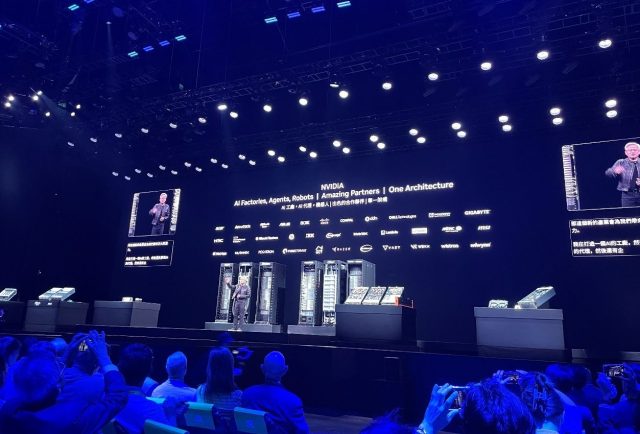
| The JH Explorer series follows our investment teams across the globe and shares their on-the-ground research at a country and company level. |
A team of Janus Henderson Investors portfolio managers and research analysts recently converged on Taipei to immerse ourselves in all things technology at the annual Computex industry conference.
As we dined on some of the country’s signature dumplings, we noted an inescapable fact: The revolutionary AI theme doesn’t happen without the extraordinary technological advances occurring in Taiwan.
With every breath, industry experts uttered the names Nvidia, Taiwan Semiconductor, and Foxconn, almost uniformly in that order. And while Nvidia and its advanced graphics processing units (GPU) have become the flagbearers of all things AI, the entire Taiwan ecosystem is the architect and builder enabling this vast technological revolution. It is perhaps no wonder that the iconic Taiwan 101 was illuminated in Nvidia green during the conference.

Building an ecosystem
Years ago, Computex was synonymous with personal computers (PCs). After that, mobility took center stage. Today, it’s almost purely a showcase for all things AI. A large portion of the exhibition space was understandably dedicated to the equipment and components that enable AI. Only upon seeing the miles of cable, highly complex liquid cooling systems, heat exchangers, racks, and cooling distribution units can one appreciate all that goes into making AI come to life.
Not surprisingly, a highlight of the week was the keynote speech by Nvidia founder and CEO Jensen Huang at the fittingly monumental Taipei Music Center.
It was striking to notice how consistent Jensen’s strategy has been over the past two decades. In conversations with him years ago, he espoused a vision of building a free base of workstations at major engineering universities to create a virtuous flywheel of talented coders who would be well-versed in Nvidia’s proprietary programming platform. Jensen believed accelerated computing would launch a world where GPUs would serve a far greater role than simply improving graphics for video games. He wanted to build an ecosystem around advanced GPUs and his company. That ecosystem is Taiwan.

Nvidia CEO Jensen Huang’s keynote speech.
For much of the world – including a large portion of the investment community – the 2022 release of ChatGPT was the “wow” moment. That belies how many years this revolution has been in the making.
The ethos of collaboration that successfully introduced AI to the world continues. An exemplar of that is a new Nvidia headquarters that is aimed to bring the company even closer to its ecosystem partners. Of greater relevance is the launch of NVLink Fusion, Nvidia’s proprietary networking architecture that allows customers to use their own AI accelerator chips in conjunction with Nvidia’s infrastructure.
As Jensen stated, “I’d love it if you buy everything from me, but just please buy something from me.”
Such a philosophy, in our view, should result in an atmosphere that furthers AI innovation as well as adoption by customers. It is not a coincidence that non-Nvidia AI accelerators – Amazon’s Trainium, for example – will invariably be designed and assembled by various Taiwanese companies.
Cracks in the AI story? None to be found
Many of the event’s attendees were looking for any sign of an AI demand slowdown. Thus far, that has proven futile. Even as production of the most state-of-the-art servers ramps up, order books for both the current and next generation remain full. Interestingly, customers appear to be staggering their purchases so as not to rely too much on any particular generation of chips. This should not only ensure fresh compute capacity for customers but also provide consistency for AI vendors.

Outside the Computex conference.
Heightened attention was paid to hyperscalers’ appetite. This, too, remains robust. And sovereign AI is another source of demand that is only starting to be quantified.
Earlier this year, the industry was briefly paralyzed with fear on the news that Chinese startup DeepSeek’s AI models were delivering impressive performance at putatively a fraction of the cost of Western models. Given the amount of capital expenditure already committed for both training and inference, this development could have proven worrisome for investors and capital allocators. Even when acknowledging that much of DeepSeek’s prowess was built on established platforms, creative, lower-cost solutions should only catalyze AI adoption rather than cannibalize existing demand.
As with other technological innovations, the bending of the cost curve should create tremendous opportunities to expand the customer base and lead to a broadening range of potential AI applications.
If you’re not first, you’re last
Given the strength of the theme – and volume of investment flows – every tech player is trying to come up with an AI story. Legacy PC and smartphone makers are selling an AI-on-device at the edge1 story, but no one is buying it (quite literally). These players are caught in a chicken-and-egg conundrum: There are no applications because there are no devices, but there are no devices because there are no applications. Again, this illustrates the genius of the nascent GPU industry playing the long game 20 years ago by partnering with engineering universities.
Sharing the wealth
Following the paths set by PCs and mobility, AI has the potential to reshape many aspects of society and how the world conducts business – perhaps even more so. As with its forebears, AI’s productivity gains will be widely dispersed.
It bears repeating that none of this is possible without the pivotal role played by Taiwan – an emerging market. Taiwan’s ecosystem is AI’s flywheel, and this was underscored by two key announcements. First, Nvidia and Foxconn are teaming up with the Taiwan government to build an AI factory featuring 10,000 GPUs to accelerate domestic AI research. Second, Nvidia has committed to building a massive spaceship-like R&D hub called Constellation in the Taipei suburbs.

Tech analyst Shaon Baqui checking out one of this year’s
Computex vendors.
Over the course of Computex, it was discussed whether Taiwan will maintain its preeminent position given the ascendency of tariffs and a potential reconfiguration of global trade. Our view is that it most certainly will. Companies, however, will likely seek to create resilience in their AI supply chains by geographically dispersing some manufacturing capacity. Mexico was more than once highlighted as a potential beneficiary of this shift.
Looking ahead, not only will emerging markets join advanced economies in delivering these innovations, but they will also increasingly deploy AI-based solutions to solve unique frictions such as e-commerce and access to finance and healthcare.
Regardless of the jurisdiction, AI is reshaping how the world operates, and those companies on the right side of innovation stand to benefit massively.
1Edge computing is the concept of pushing compute capacity closer to the end user, e.g. on mobile devices.
All opinions and estimates in this information are subject to change without notice and are the views of the author at the time of publication. Janus Henderson is not under any obligation to update this information to the extent that it is or becomes out of date or incorrect. The information herein shall not in any way constitute advice or an invitation to invest. It is solely for information purposes and subject to change without notice. This information does not purport to be a comprehensive statement or description of any markets or securities referred to within. Any references to individual securities do not constitute a securities recommendation. Past performance is not indicative of future performance. The value of an investment and the income from it can fall as well as rise and you may not get back the amount originally invested.
Whilst Janus Henderson believe that the information is correct at the date of publication, no warranty or representation is given to this effect and no responsibility can be accepted by Janus Henderson to any end users for any action taken on the basis of this information.